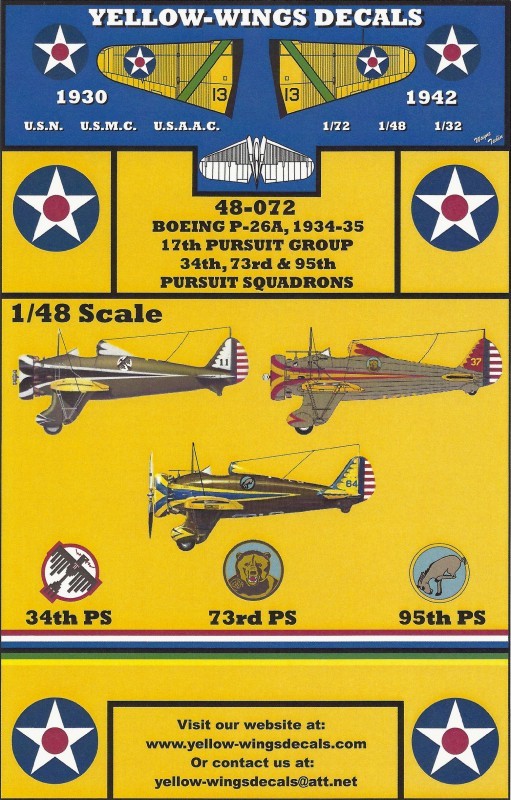USAAC Boeing P-26A Peashooter
I would like to thank Yellow-Wings Decals for this review sample and IPMS/USA for allowing me to review it.
The U.S. military had some of the most colorful aircraft ever prior to WWII. There were bands of bright colors on the fuselage and chevrons on the upper wings to identify section leaders. The rudders had red, white, and blue stripes. Bright tail colors were added to identify squadrons or assigned carriers. The national insignia was a large blue roundel surrounding a white star with a red roundel in the center. Added to all this were the orange-yellow wings and horizontal stabilizers. The color schemes could not get more garish. But, they did. Enter the Boeing P-26.
Designed and built by Boeing in the early 1930s the P-26 was the first all-metal monoplane production fighter aircraft used by the United States Army Air Corps, USAAC. However, it was a transitional design retaining the wire-braced wings, fixed landing gear and open cockpit of previous designs.
The USAAC pursuit squadrons began taking delivery of the P-36 in December 1933. It wasn't long before the pursuit squadrons began to "personalize" their P-26s. In addition to the required tail, rudder, and wing colors, they added "racing stripes" down the fuselage from nose to tail in squadron colors. The paint shop did not forget the headrest and wheel pants for they were painted in colorful motifs as well.
Yellow-Wings Decals has recently released a set (48-072) of 1/48-scale decals for the P-26A that captures the showy paint schemes used in the late 1930s. The suggested model kit is the Academy/Hobbycraft Boeing P-26A "Peashooter." Printed by Microscale, this set of decals includes markings for three 17th Pursuit Group squadrons: the 34th Thunderbirds, the 73rd Golden Bears, and the 95th Kicking Mules.
This release comes in a clear zip-lock plastic envelope. The package contains a brief history of the P-26 and its paint schemes. The instructions for decal placement are quite detailed and include painting instructions. The paint callouts only refer to FS numbers. Also included are clear and detailed instruction for all stencil placements. In all, there are eight pages of instructions and line drawings for the three airplanes.
The only suggestion I have to improve on the instructions is to include the locations for the smallest aircraft number and to clarify the location of the large in-line aircraft numbers. After a few minutes surfing the Internet I found pictures showing the smallest aircraft number near the top of the crankcase fairing and the large in-line numbers on the centerline of the fuselage behind the faired headrest and on the belly in the general area of the wing trailing edge.
The decals come on three sheets. Each sheet is crisply printed and in beautiful colors. The registery is perfect. The carrier film is at a bare minimum around each article. The decals are very thin and should go on very easily and lay down tight against panel lines, bumps, and ridges.
While the instructions might need an additional piece of information, my overall assessment of this set of decals is excellent. A P-26 dressed out in any one of these markings will certainly be eye catching and will look great sitting on display. I can easily give this product a high recommendation.
Again, thank you Yellow-Wings Decals.






Comments
Add new comment
This site is protected by reCAPTCHA and the Google Privacy Policy and Terms of Service apply.
Similar Reviews